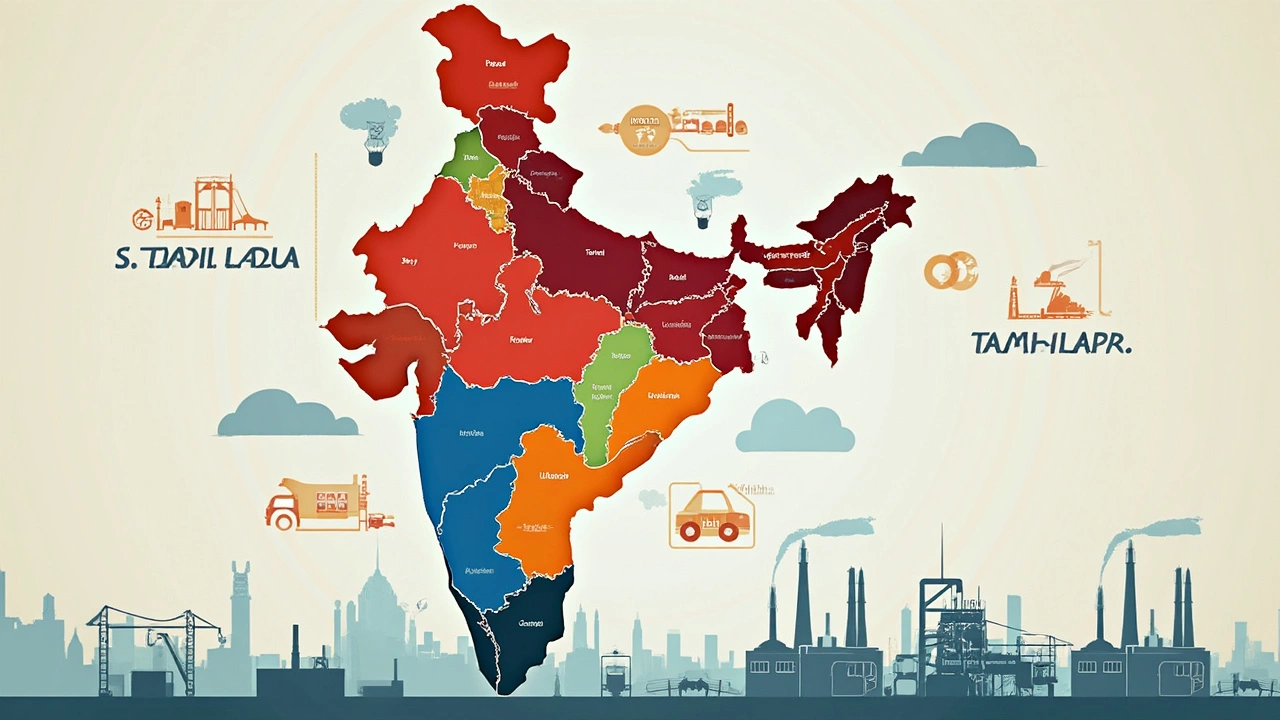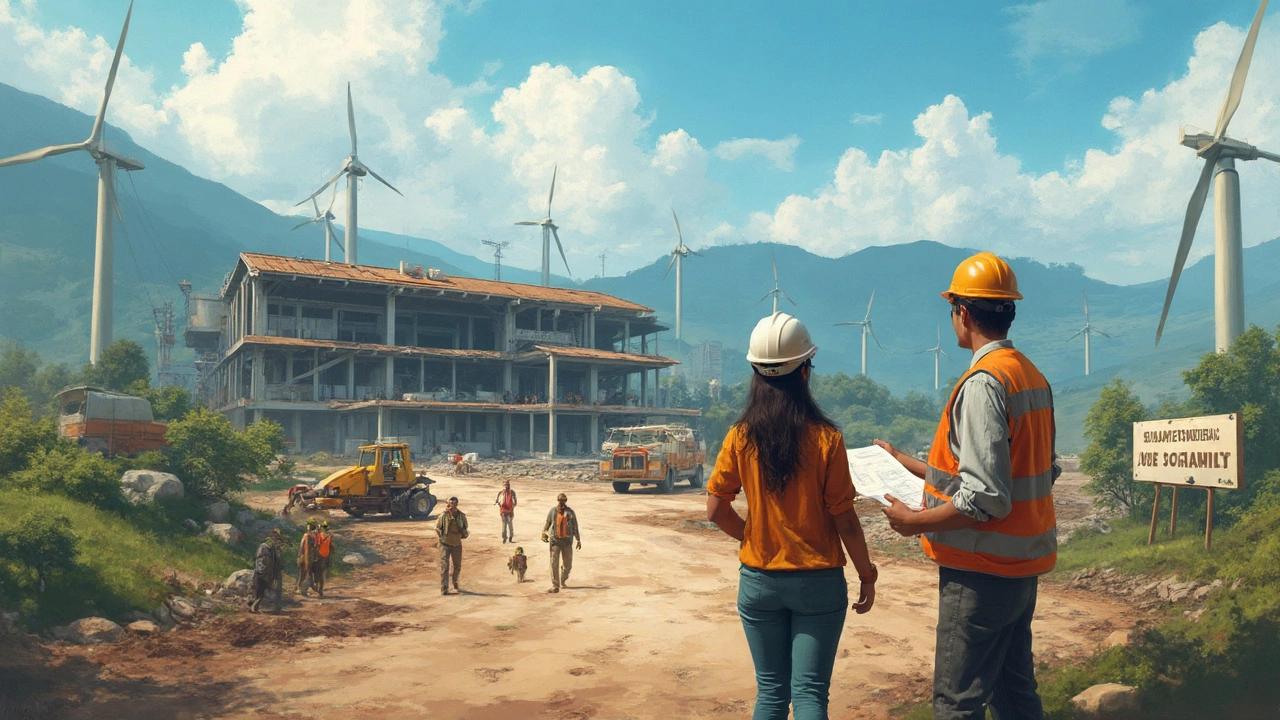Choosing the best state to build your factory isn’t just about sticking a pin on the map. Costs, government schemes, local talent, and even weather can make a huge difference in your bottom line. Picking the right state means higher profits and fewer headaches down the road.
If you jump at headlines about 'tax holidays' or 'mega parks' without digging deeper, you could get burned. For example, a friend of mine set up a manufacturing unit in a state with a flashy incentive—turned out, the red tape was never-ending and skilled workers were nowhere to be found. Doing your homework is way better than learning the hard way.
The good news? Some states roll out the red carpet for factories: land at a discount, cheaper electricity, and cash back for every job you create. But not all incentives are what they seem—some come with strings attached, or just aren’t practical long term. Knowing what to look out for means you won't waste money and time.
- What Makes a State Good for Manufacturing?
- Top States and Their Government Incentives
- Hidden Costs and Local Challenges
- Practical Tips for Choosing the Right State
What Makes a State Good for Manufacturing?
Picking where to plant your factory is a big call. So, what separates an okay state from a standout? It all comes down to how much help you get, what it costs, and whether you can actually run your operation smoothly once you set up shop.
If you’re set on running a factory that stays profitable, here’s what to watch:
- Government Incentives: States offer cash rebates, tax breaks, and cheap land for manufacturing. Look at both state and local perks. For example, Tamil Nadu’s “Special Package of Incentives” offers up to 50% capital subsidy for major projects.
- Infrastructure: Fast internet is great, but what about power cuts, bad roads, or limited water supply? Gujarat and Maharashtra get high marks for ports, highways, and steady electricity—less downtime for your machines.
- Labour Skill and Cost: You need talent, not just warm bodies. Karnataka and Telangana have strong engineering talent pools and training programs. But, rising wages in some zones may sneak up on you later.
- Raw Material Access: States close to supply sources (like Chhattisgarh for steel or Punjab for food processing) save big on transport costs and avoid headaches when there are delays.
- Regulatory Environment: States with single-window clearances (like Andhra Pradesh) make setting up so much faster compared to old-school files and endless queues.
Here’s a quick look at how some leading states stack up on key factors for manufacturing:
| State | Average Power Cost (INR/unit) | Skilled Labour Availability | Tax Breaks | Ease of Doing Business Rank (2024) |
|---|---|---|---|---|
| Gujarat | 7.2 | High | 5-year holidays | 1 |
| Tamil Nadu | 7.1 | High | 50% capital subsidy, stamp duty waiver | 2 |
| Maharashtra | 8.0 | Medium | CST exemption, entry tax waiver | 3 |
| Karnataka | 8.4 | Very High | Stamp duty, electricity fee exemption | 4 |
Notice the gaps? Power costs swing, tax perks differ, and talent isn’t everywhere. Before making a move, check what really matters for your product. Your goal is predictable costs and as little red tape as possible—don’t just chase the biggest discount. The right state gives you breathing space to grow, not just a warm welcome at the ribbon cutting.
Top States and Their Government Incentives
When it comes to picking the best state to build a factory, you can’t ignore what each government is offering. Some states are in a race to attract manufacturers, and the deals can get pretty sweet—if you know where to look.
Let’s break down what’s on the table in some of the leading states:
| State | Main Incentives | Extra Perks | Industry Focus |
|---|---|---|---|
| Tamil Nadu | Capital subsidies up to 25%, interest-free loans, single window clearance | Land at reduced rates, 24/7 power guarantee | Automotive, electronics, textiles |
| Gujarat | Interest subsidy up to 7%, no stamp duty, plug-and-play infrastructure | Priority water/power, fast approvals | Pharma, engineering, chemicals |
| Maharashtra | 50% subsidy on SGST, stamp duty exemptions, power tariff subsidies | Special export zones, easy credit | Automotive, food processing, electronics |
| Karnataka | Production subsidies, land rebate up to 75%, low rental in industrial parks | Skill development support | Electronics, aerospace, biotech |
| Uttar Pradesh | 20-40% capital subsidy, reimbursement of state GST | Fast-track clearances, transport subsidies | Textiles, electronics, food |
To break it down even more, Tamil Nadu’s single window clearance really stands out if you hate paperwork and delays. Gujarat goes big on quick plug-and-play setups—it’s a hit with companies wanting to hit the ground running. Maharashtra makes SGST a lot less painful, plus you’ll find special export zones set up to make global sales easy.
Karnataka is worth a look if you need skilled labor, especially for tech-driven manufacturing. The government will even chip in for workforce training and give you a break on rent in industrial parks. Meanwhile, Uttar Pradesh makes it easier than ever to recoup your investment by giving back a chunk of what you spend through subsidies.
Don’t just scan the headlines—actually get the details. Some of the best incentives kick in only for big-ticket projects or certain industries. Check the fine print and talk directly to the state’s investment promotion office—many are now pretty responsive over WhatsApp and email, which saves a lot of time compared to old-school visits.

Hidden Costs and Local Challenges
It’s tempting to focus on the big government incentives and forget the tricky little things—the stuff that eats away at your margins. The best state for a factory sometimes looks less shiny when you factor in costs nobody warns you about.
Take land prices: sure, the state offers cheap plots, but setting up in a remote area often means spending a fortune on basic infrastructure—think roads, water supply, and logistics. For example, while Gujarat’s Sanand is famous for its auto hub, real estate prices there have doubled in the last six years and traffic congestion is now a daily headache.
Labor isn’t just about the minimum wage. In states like Maharashtra, strikes and union demands can cause surprise expenses or delays. And not every area has workers with the skills you need. Sometimes you’ll have to invest in training, or even arrange extra housing, especially if you’re setting up somewhere like Andhra Pradesh or Odisha where skilled labor supply fluctuates.
Local rules can quietly trip you up. You might read about single-window clearances, but in reality, paperwork can drag on for months—especially if you don’t have the right connections. In Tamil Nadu, electricity connections often take way longer than promised, leading to project delays that rack up costs fast.
- Power outages: Some states, particularly in North India, still see frequent outages. Backup generators aren’t cheap.
- Logistics bottlenecks: Factories near ports (like in Gujarat or Tamil Nadu) move goods faster and cheaper. Inland setups often struggle with delays at state borders due to interstate taxes and tolls.
- Environmental rules: Compliance has gotten tougher, especially in areas close to protected forests or rivers. If your plant relies on lots of water, forget about setting up near Bengaluru—groundwater is running dangerously low.
Here’s a quick look at hidden costs in popular states:
| State | Hidden Cost | Extra Details |
|---|---|---|
| Gujarat | Rising land rates | Prime industrial zones up over 40% since 2018 |
| Uttar Pradesh | Frequent power cuts | Backups needed, adds 8-12% to energy bills |
| Maharashtra | Labor unrest | Shutdown risk, average delay: 10-14 days/year |
| Andhra Pradesh | Training costs | Skill gap means 15% higher onboarding outlay |
The bottom line: every state has its own set of hidden costs and local curveballs. Visit the area, talk to businesses already set up there, and run the numbers beyond the basic incentives. Focusing only on the government promos can cost you way more than you expect.
Practical Tips for Choosing the Right State
Picking where to set up your best state factory isn’t about luck. You need hard facts and a solid checklist. Here’s what actually matters on the ground.
- Calculate total cost, not just land price. Cheap land gets headlines, but real savings come from lower power rates, tax breaks, and easy logistics. For example, states like Gujarat and Tamil Nadu offer lower power costs per unit compared to the national average, slicing long-term bills.
- Check the labor pool and skill level. Are there training institutes around? What about local ITIs or polytechnics? For high-tech manufacturing, states like Karnataka and Maharashtra have a better-trained workforce. If you're building widgets, look for states investing in skills training.
- Understand state schemes. Some states give fat incentives but demand yearly paperwork or proof of local hiring. Read the fine print, or you might spend more time chasing approvals rather than running your business.
- Measure real connectivity. How close are ports, airports, highways, and big cities? Nobody wants to be 200 km from the nearest good road. For exports, Maharashtra and Tamil Nadu are hard to beat, with good ports and rail links.
Neha always says, "Don’t just look at glossy brochures—call up someone running a plant already." That’s honestly gold advice. Some state governments even host factory tours for investors—ask about these and see things for yourself.
“Government policies are good, but execution on the ground matters more. Always double-check what’s promised with actual business owners.”
— Rajat Sharma, CEO, Eastman Industries
To get a sense of what’s on offer beyond the flashy headlines, compare actual stats. Here’s a quick table of stats (not exhaustive, but these numbers matter):
| State | Average Power Cost (INR/unit) | Corporate Tax Incentives | No. of Industrial Parks |
|---|---|---|---|
| Gujarat | 6.5 | Up to 50% capital subsidy | 42 |
| Tamil Nadu | 6.7 | Interest-free loans on VAT | 35 |
| Maharashtra | 7.3 | Stamp duty waiver | 90 |
Tip: Always visit the State Industrial Development Corporation website for the latest details. And don’t be swayed by a big signboard—talk to other factory owners before making your final call.
